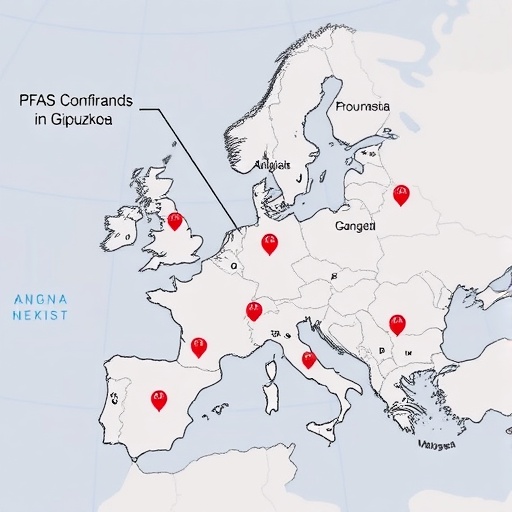A groundbreaking longitudinal study conducted by researchers at the University of the Basque Country (EHU) has shed new light on the pervasive exposure of children to per- and polyfluoroalkyl substances (PFAS), a class of highly persistent man-made chemicals. These compounds, prized for their water-, oil-, and stain-resistant properties, are omnipresent in everyday household items such as non-stick cookware, waterproof textiles, food packaging, and firefighting foams. Their remarkable chemical stability, however, comes with a significant environmental and health cost, as PFAS accumulate in ecosystems and human bodies over extended periods.
The research explores early-life exposure to PFAS in a cohort of 315 children, tracking plasma levels of these chemicals at critical developmental stages—ages 4, 8, and 14. The study identified 18 PFAS variants from a panel of 42 commonly analyzed compounds, with detection frequencies ranging from 70% to 97% for the most prevalent. This widespread bioaccumulation underscores the chronic nature of human contact with these contaminants. Despite ongoing regulatory efforts, the findings suggest that PFAS exposure remains alarmingly high in pediatric populations, raising urgent questions about the adequacy of current safety thresholds and risk management frameworks.
PFAS’s potential to disrupt endocrine function and affect cholesterol profiles, liver function, and developmental processes has been increasingly documented. Notably, the chemicals’ persistence means that their harmful effects may not manifest immediately, complicating efforts to assess risk based on conventional toxicological models. Current risk evaluations rely heavily on animal studies, which may not fully capture human-specific responses, particularly for vulnerable groups such as children. This necessitates a reevaluation of toxicological paradigms and the incorporation of biomonitoring data to develop more nuanced, human-centered exposure assessments.
The study’s focus on children is particularly significant because early life stages represent windows of heightened vulnerability. The developing embryo and infant are susceptible to lower doses of toxins, which may instigate lifelong health repercussions. Maternal transfer of PFAS occurs prenatally across the placenta and postnatally through breastfeeding, magnifying early exposure before additional environmental sources take precedence as children age. This longitudinal approach allowed the researchers to delineate patterns of exposure and bioaccumulation through key developmental milestones, providing unprecedented insight into the timing and dynamics of PFAS uptake.
Intriguingly, the data reveal an age-dependent trend in PFAS profiles. Younger children exhibited predominance of legacy compounds such as perfluorooctanoic acid (PFOA) and perfluorooctane sulfonate (PFOS), which have been subject to regulation and phase-out measures since 2006. In contrast, adolescents showed elevated concentrations of emerging PFAS variants likely introduced after the earlier bans, highlighting the chemical industry’s substitution patterns. These findings emphasize the importance of continuous surveillance to capture evolving contamination landscapes and inform adaptive regulatory strategies.
The sampling regions, Gipuzkoa’s Goierri and Urola districts, add a critical contextual layer due to their historical association with heavy industrial activities, particularly iron and steel manufacturing. This geographic specificity enhances the ecological relevance of the findings, as industrial emissions may contribute to localized PFAS burdens. By integrating spatial and temporal data, the study offers a robust framework to understand the cumulative impact of both historical and current exposures on human health in industrialized settings.
Although the study did not find immediate evidence of acute toxicity or alarming PFAS concentrations in the pediatric cohort, the absence of detectable short-term harm does not preclude long-term health consequences. The slow degradation rates of PFAS—measured in years, if not decades—coupled with their bioaccumulative characteristics, suggest potential latent effects that only future longitudinal follow-ups can elucidate. This uncertainty highlights the precautionary principle’s importance in environmental health policy and the need for proactive measures to minimize exposure.
The regulatory landscape currently governing PFAS remains fragmented and often outdated. While certain well-known PFAS compounds have been restricted, the rapid emergence of novel PFAS variants outpaces legislative responses. The persistence of restricted PFAS in children’s bloodstreams post-regulation further attests to regulatory gaps and legacy contamination. This research advocates for revised, comprehensive regulation encompassing a broader spectrum of PFAS chemicals, underpinned by rigorous toxicity data and biomonitoring evidence.
Researchers emphasize the necessity for refined analytical techniques in PFAS detection. Non-targeted and high-resolution mass spectrometry methodologies, as developed by the IBea research group at EHU, enable the identification of previously unrecognized or novel PFAS compounds. Such advances are critical to unraveling the complex chemical mixtures involved in exposure scenarios and to formulating targeted mitigation strategies. Enhanced analytical precision will also improve toxicological risk assessments and public health surveillance.
Collaborative efforts between environmental scientists, toxicologists, public health officials, and policymakers are imperative to translate these findings into actionable health guidelines. The integration of community-based biomonitoring initiatives, longitudinal birth cohorts like INMA, and industrial emission controls can foster a multifaceted response to PFAS contamination. Importantly, public awareness campaigns must accompany scientific research to inform and empower affected populations, particularly parents and caregivers of young children.
Future research directions include longitudinal health outcome tracking, mechanistic studies elucidating PFAS modes of action at the cellular level, and development of remediation technologies to reduce environmental PFAS reservoirs. The study underscores the complex interplay between chemical innovation, exposure science, and regulatory policy, calling for adaptive governance frameworks responsive to emerging contaminants’ evolving profiles. Only through such concerted efforts can the insidious public health challenge posed by PFAS be mitigated.
In conclusion, the EHU study represents a critical advance in understanding PFAS exposure patterns during childhood—a period of profound biological vulnerability. It exposes significant challenges in current regulatory paradigms and highlights the urgent need for comprehensive biomonitoring coupled with human-centric toxicological approaches. As PFAS compounds continue to pervade daily life, sustained scientific inquiry and robust regulatory frameworks will be vital to safeguarding public health now and into the future.
Subject of Research: Longitudinal assessment of early-life exposure to per- and polyfluoroalkyl substances (PFAS) in children from the INMA Spanish birth cohort.
Article Title: Tracking early-life PFAS exposure in children at ages 4, 8, and 14 years: A longitudinal study from the INMA Spanish birth cohort.
News Publication Date: 25-Jun-2025
Web References:
Anne San Román, University of the Basque Country: https://www.ehu.eus/es/web/basque-environmental-health-research-group/-/anne-san-rom%C3%A1n
Nestor Etxebarria, University of the Basque Country: https://www.ehu.eus/es/web/ibea/personal-permanente/nestor-etxebarria-loizate
Department of Analytical Chemistry, EHU: https://www.ehu.eus/es/web/kas/aurkezpena
Research Centre for Experimental Marine Biology & Biotechnology in Plentzia (PiE-EHU): https://www.ehu.eus/PIE/
IBea research group: https://www.ehu.eus/es/web/ibea
References:
Environmental Research, DOI: 10.1016/j.envres.2025.122198
Image Credits: Credit: file photo. EHU
Keywords: Health care, Health and medicine, Human health, Blood chemical analysis, Diseases and disorders
Tags: bioaccumulation of PFAS in humansendocrine disruption from PFASenvironmental impact of perfluoroalkyl substanceshealth effects of PFAS in pediatricslong-term effects of PFAS exposurelongitudinal study on PFAS in GipuzkoaPFAS contamination in children’s bloodPFAS variants in children’s plasmaprevalence of PFAS in household productsregulatory challenges for PFAS safetystudy on children’s exposure to PFASurgent need for PFAS risk management.





